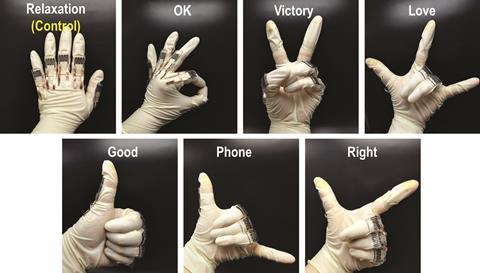 Scientists in China have printed conductive 3D graphene structures and applied them in a wearable electronic device that can translate common sign language gestures into written text. Given the simplicity underpinning its manufacture, during which graphene ink is extruded from a syringe, this material could inject some pace into the printed electronics field.
Scientists in China have printed conductive 3D graphene structures and applied them in a wearable electronic device that can translate common sign language gestures into written text. Given the simplicity underpinning its manufacture, during which graphene ink is extruded from a syringe, this material could inject some pace into the printed electronics field.Wearable and bio-integrated devices are mainstays in medical technology, ranging from adhesive patches that measure heart and respiratory rate to brain–computer interfaces that induce neural activity. Its remarkable mechanical and electrical properties cast graphene, a 2D honeycomb lattice of carbon atoms, as a key future player in the wearable technology arena. However, it is a challenge to preserve the advantages of graphene’s sheet-like nanostructure in a 3D material that – unlike typical 2D materials – can relay information about forces from every angle.
Read the full article in Chemistry World >>>
Three-dimensional multi-recognition flexible wearable sensor via graphene aerogel printing
Boxing An, Ying Ma, Wenbo Li, Meng Su, Fengyu Li and Yanlin Song
Chem. Commun., 2016, 52, 10948-10951
DOI: 10.1039/C6CC05910D, Communication










